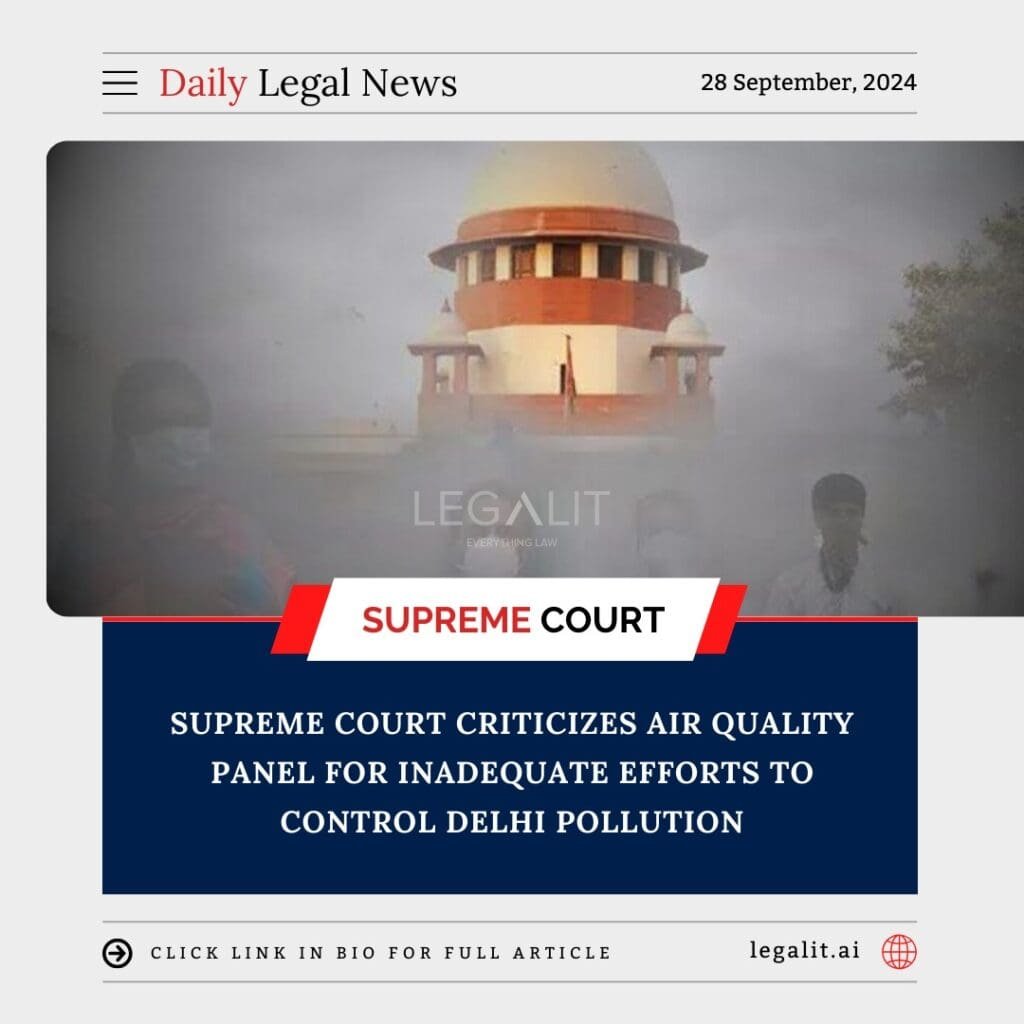
The Supreme Court of India has expressed dissatisfaction with the performance of the air quality management panel responsible for addressing pollution in the National Capital Region (NCR), particularly in Delhi. The apex court highlighted the worsening air quality in the city, stating that the measures implemented by the panel have not been sufficient to tackle the persistent pollution problem, especially with the onset of the winter season when the air quality typically deteriorates.
1. The Pollution Crisis in Delhi
Delhi has long been grappling with severe air pollution, primarily caused by a combination of vehicular emissions, industrial activities, stubble burning in neighboring states, and dust from construction sites. During the winter months, pollution levels in the city often reach hazardous levels, leading to public health concerns and visibility issues.
In recent years, various steps have been taken by both the central and state governments to mitigate the pollution crisis, including the establishment of an air quality management panel. However, despite these efforts, air pollution in Delhi continues to be a significant issue, causing alarm among environmentalists, health professionals, and the general public.
2. Supreme Court’s Observations
During the latest hearing on the pollution crisis, the Supreme Court reprimanded the air quality panel for failing to take adequate steps to curb the pollution in Delhi. The Court observed that despite the panel’s formation and the availability of various resources, the situation on the ground has not improved significantly.
- Lack of Concrete Action: The Supreme Court pointed out that the panel had been more focused on issuing directives and advisories rather than implementing concrete actions to reduce pollution. The justices questioned whether the panel had taken enough steps to address the root causes of pollution, such as vehicular emissions, industrial discharges, and stubble burning in nearby states.
- Stubble Burning: The Court was particularly critical of the panel’s response to stubble burning, which is a major contributor to the seasonal spike in pollution levels. Despite the issue being discussed repeatedly in previous hearings, the Court observed that little progress had been made in coordinating with states like Punjab, Haryana, and Uttar Pradesh to curb this practice.
- Long-Term Solutions: The Court stressed the need for long-term, sustainable solutions rather than short-term fixes that are implemented only when pollution levels reach alarming levels. It emphasized the importance of policy consistency and year-round efforts to ensure that Delhi’s air quality improves permanently.
3. Government’s Response
In response to the Supreme Court’s criticisms, representatives from the air quality management panel and the central government acknowledged the ongoing challenges but assured the Court that steps were being taken to address the issue. These steps included deploying more air quality monitoring stations, enforcing stricter pollution control measures in industries, and working with state governments to find alternatives to stubble burning.
- Vehicular Emissions: One of the primary areas of focus is reducing emissions from vehicles, which are a major source of air pollution in Delhi. The government has been promoting the use of electric vehicles, implementing odd-even traffic schemes, and encouraging the use of public transport to reduce the number of cars on the road.
- Industrial Pollution: Authorities have also been focusing on controlling emissions from factories and construction sites. Stricter penalties for non-compliance with environmental regulations and improved monitoring of industrial activities have been implemented to curb pollution from these sources.
- Public Awareness Campaigns: The government has also been investing in public awareness campaigns to educate citizens about their role in reducing pollution, such as minimizing the use of personal vehicles, avoiding outdoor burning, and supporting green initiatives like tree planting and the use of cleaner energy sources.
4. Health Impacts of Delhi Pollution
The Supreme Court’s intervention comes at a time when the health impacts of air pollution in Delhi have become increasingly concerning. Prolonged exposure to poor air quality can lead to respiratory problems, cardiovascular diseases, and even premature death. Vulnerable populations such as children, the elderly, and those with pre-existing health conditions are particularly at risk.
With air pollution levels in Delhi frequently surpassing the World Health Organization’s (WHO) recommended safe limits, the city has earned the reputation of being one of the most polluted capitals in the world. The Court’s insistence on urgent action reflects the growing recognition of air pollution as a public health emergency.
5. Looking Ahead: The Court’s Expectations
The Supreme Court has made it clear that it expects more robust action from the air quality management panel. It has directed the panel to submit a detailed plan outlining specific measures that will be taken to curb pollution, along with timelines for implementation. The Court also stressed the need for better coordination between the central government, state governments, and local authorities to ensure that efforts to reduce pollution are not fragmented or delayed.
- Monitoring and Accountability: The Court has called for improved monitoring mechanisms to track the effectiveness of anti-pollution measures. It emphasized the need for accountability at all levels of government to ensure that pollution control policies are enforced consistently.
- Public Participation: The justices also highlighted the importance of involving the public in efforts to reduce pollution. Encouraging citizens to adopt environmentally friendly practices, such as reducing personal vehicle usage and conserving energy, will be critical to achieving long-term success in combating pollution.
6. Conclusion
The Supreme Court’s criticism of the air quality panel underscores the gravity of Delhi’s pollution crisis and the urgent need for more effective action. While the government and its agencies have taken steps to address the issue, the Court’s intervention suggests that these efforts have been insufficient. Moving forward, the focus will be on implementing sustainable, long-term solutions that can bring about tangible improvements in the city’s air quality.